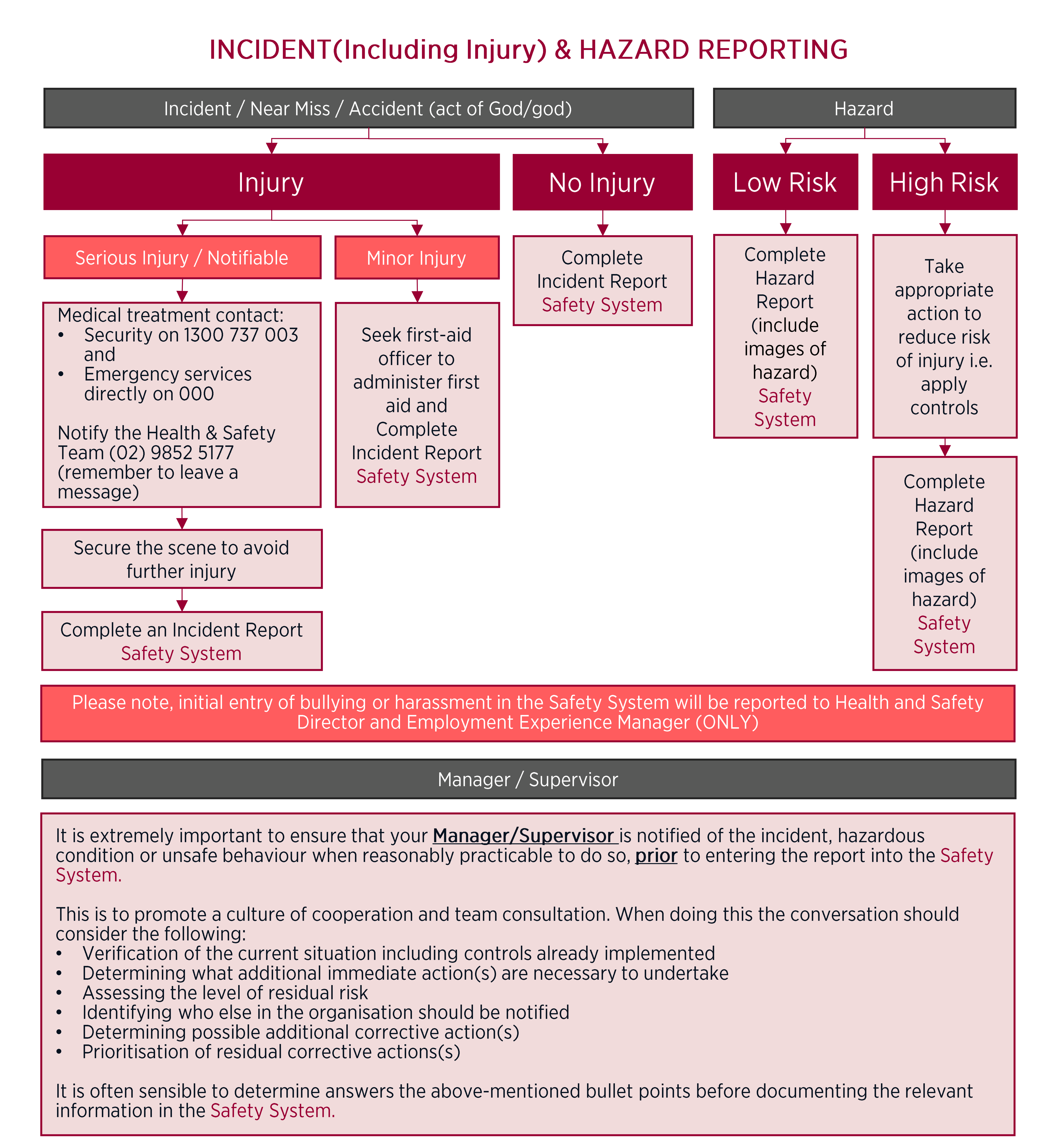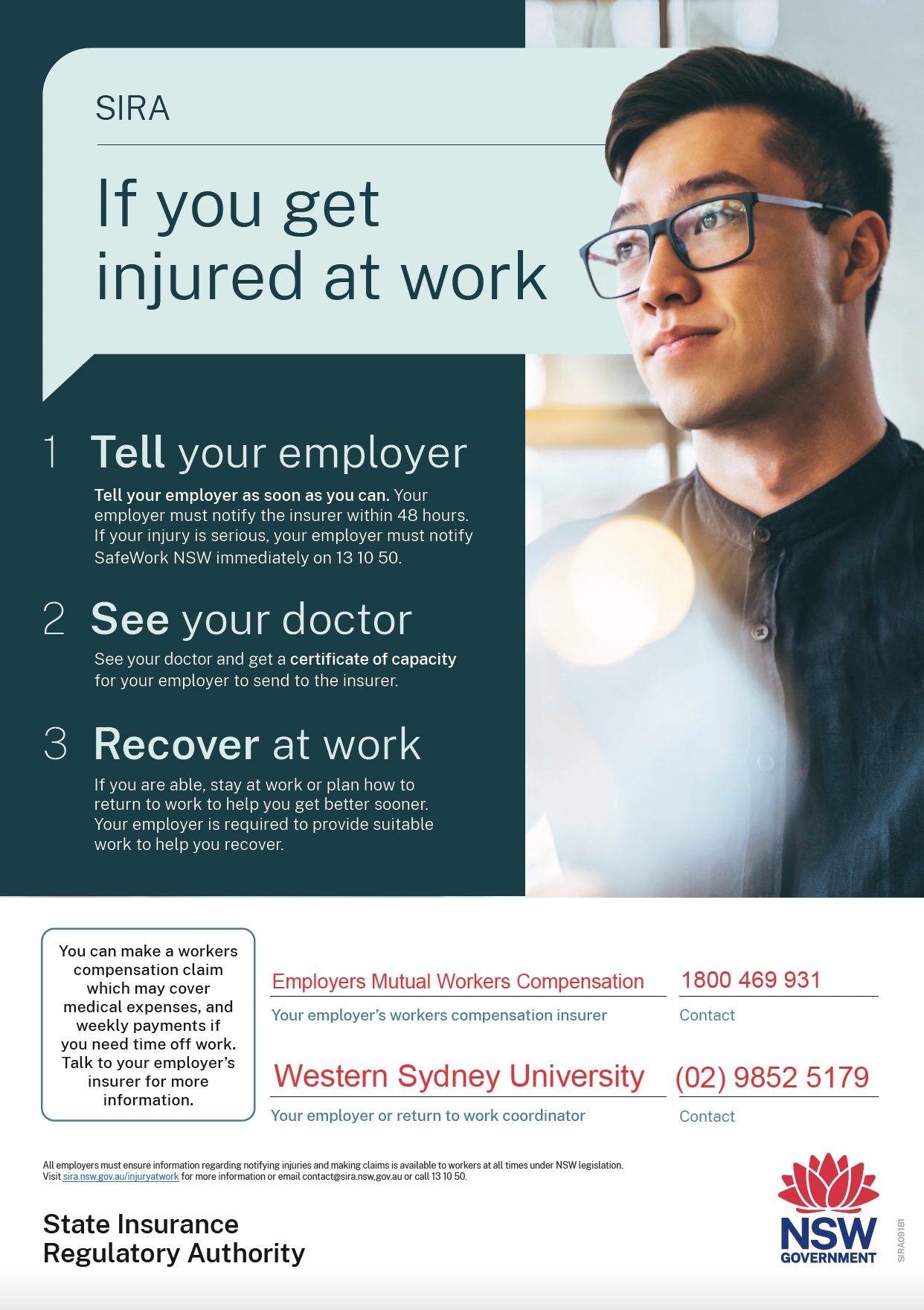Report an Incident (including injury) or Hazard
Incident and hazard management is an important aspect of the Western Sydney University Health and Safety management system, and is a key legislative requirement. Reporting of incidents and hazards and then the prioritisation of action implementation helps create a safe and healthier work environment for all.
Incident Reporting Flow Chart

Reporting an incident or hazard
To report an incident or hazard, complete the appropriate form using the links/buttons provided on this page (via DoneSAFE).
You can report a hazard or incident on behalf of others, including students, colleagues, contractors and visitors.
Visitors and contractors can access the public form to report the hazard or incident themselves as well.
Before submitting a hazard or incident in the system, it is highly recommended that you report the matter to your supervisor immediately (if convenient, appropriate or safe to do so). There is no need to copy the Health and Safety Team when completing the incident or hazard report.
The University's Incident and Hazard Reporting and Investigation Policy provides more information on reporting and investigation requirements.
For notifiable incidents or Dangerous Occurrences, as defined by legislation and included on this page for your convenience, please do select Notifiable/Dangerous Occurrence when reviewing/approving the incident report.
Definition of a hazard
Hazard means a situation or thing that has the potential to harm a person. Hazards at work may include: noisy machinery, a moving forklift, chemicals, electricity, working at heights, a repetitive job, bullying and violence at the workplace.
Definition of an incident
An incident is defined as an event resulting in, or having a potential for injury, ill health, damage or other loss.
If you believe an incident may be notifiable, notify the WHS&W Director on 02 9852 5177 immediately.
What is a notifiable incident?
Under the WHS act, a notifiable incident means:
- the death of a person
- a serious injury or illness of a person
- a dangerous incident
If you believe an incident may be notifiable, notify the WHS&W Director on 02 9852 5177 immediately.
What is a serious injury or illness?
A serious injury or illness means an injury or illness requiring a person to have:
- immediate treatment as an in-patient in a hospital
- immediate treatment for:
- a serious head injury
- a serious eye injury
- a serious burn
- the separation of skin from an underlying tissue (such as degloving or scalping
- a spinal injury
- the loss of a bodily function
- a serious laceration
- medical treatment within 48 hours of exposure to a substance
If you believe an incident may be notifiable, notify the WHS&W Director on 02 9852 5177 immediately.
What is a dangerous incident?
A dangerous incident is where any person is exposed to a serious result resulting from an immediate or imminent exposure to:
- an uncontrolled escape, spillage or leakage of a substance
- an uncontrolled implosion, explosion or fire
- an uncontrolled escape of gas or steam
- an uncontrolled escape of a pressurised substance
- electric shock
- the fall or release from a height of any plant, substance or thing
- the collapse, overturning, failure or malfunction of, or damage to, any plant that is required to be design or item registered under the Work Health and Safety Regulations, for example a collapsing crane
- the collapse or partial collapse of a structure
- the collapse or failure of an excavation or of any shoring supporting an excavation
- the inrush of water, mud or gas in workings, in an underground excavation or tunnel
- the interruption of the main system of ventilation in an underground excavation or tunnel.
If you believe an incident may be notifiable, notify the WHS&W Director on 02 9852 5177 immediately.
Mobile options:


